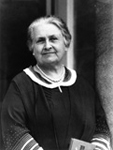
Maria Montessori
The American Montessori Society (n.d.) describes Maria Montessori as an influential and pioneering educator. She was a physician, scientist, and innovator that used her observation skills to see how children interacted with their environment. She graduated from medical school in 1896, and her primary focus was psychiatry. She became interested in education, which inspired her to observe and question teaching methods in special education.
Maria Montessori used a scientific approach and ongoing observations to develop her teaching methods. In 1907, she opened her first school Casa de Bambini for children ages 3-7. She continued to observe and reflect and from there the Montessori Method was formed. She believed schools needed more liberty and freedom that could be restricted by the used of a desk, children naturally absorbed information and knowledge from the world around them. She designed prepared learning environment with didactic materials, intended to teach and captured a child’s natural desire to learn. Children were thriving in her learning environments and showed great concentration, attention and self-discipline as they worked. By 1910 additional Montessori schools were opening around the world.
Follow the child, they will show you what they need to do, what they need to be challenged in.
~Maria Montessori
The Prepared Environment
Maria Montessori described a classroom as a prepared environment, a “dynamic triad of child, teacher, and environment. One part of a teacher’s role is to guide the child through what Montessori termed the prepared environment, i.e., a classroom and a way of learning that are designed to support the child’s intellectual, physical, emotional and social development through active exploration, choice and independent learning.” (Marshall, 2017)
The teachers role is to prepare the environment with “carefully selected, aesthetically arranged materials that are presented sequentially to meet the developmental needs of the children using the space.” (https://amshq.org/About-Montessori/What-Is-Montessori/Terminology)
The Planes of Development
Maria Montessori outlined four planes, or stages of development from birth to 24 years. Each plane of development highlights how children learn, what motivates them at each unique stage, and “provides a holistic view of the developing human being.” (Grazzini, 2004)
- The Absorbent Mind (birth-6 years)
- During this stage of development a child’s mind absorbs the world around them like a sponge, from birth to 3 years learning in through an unconscious state gradually moving towards a conscious state between 3-6 years. A child’s hands and senses guide their learning.
- The Reasoning Mind (6-12 years old)
- During this stage a child is hungry for culture, building knowledge and understanding about the world around them. They are powered by imagination, abstract thought and reasoning. This plane of development is described as the “calm phase of uniform growth.” (Grazzini, 2004)
- Social Consciousness (12-18 years)
- This is the stage of transformation. A child is beginning to enter the stage of adulthood and becoming a member of society. It is time of change with puberty, hormones, and growing independence as the adolescent finds their place in the world. (Grazzini, 2004)
- Transition to Adulthood (18-24 years)
- This is the stage of maturity, spiritual and moral independence creating a “personal mission in life.” (Grazzini 2004)
The Curriculum
Montessori has a rich curriculum “Cosmic Education is the foundation for the entire Montessori elementary curriculum” (Duffy & Duffy, 2014, pg. 1). Cosmic Education is comprised of History, Earth Science, Zoology and Botany curriculum. The main goal of Cosmic Education is “to guide the child toward an initial examination of the question ‘Who am I?’” (Duffy et al., 2014). As a child begins to answer this question ‘Who am I’ the child begins to reveal answers about their and who they are in the world (Duffy, et al.).
- The Montessori curriculum also encompasses traditional subjects including Math and Language but enriches curriculum with Sensorial (activities to develop and refine the senses) and Practical Life (purposeful activities to prepare a child for real life).
- Montessori lesson are “presented through an integrated approach that weaves separate strands of the curriculum together.” This way of guiding learners highlights the interrelatedness of everything in the world, allowing a child to become completely immersed in a topic and promote inquiry and curiosity. (https://amshq.org/Families/Why-Choose-Montessori/Montessori-FAQs#curriculum)
Montessori In Nature
Maria Montessori dedicated a chapter in her novel The Discovery of the Child (1946) to Montessori in Nature. As a scientist she saw great value in beauty that nature can provide. She described children as natural observers, and they must have contact with nature to understand the world around them. She viewed the outdoors as an extension of the indoor classroom that promotes optimal development in each developmental domain (physical, emotional, social and cognitive development) and allows for endless experimental learning opportunities.
- She described that children have a natural concern for living things. She placed emphasis on the importance of drawing attention, indicating, naming, distinguishing living things.
- Gardens play an integral role in learning outdoors and provided excellent opportunities for Practical Life, throughout each stage of the garden from sowing the seeds to reaping the harvest.
“Going Out” experiences provide the opportunity for children to plan explorations in their community based on their interests and integrate real life experiences back into their studies in the classroom (Lillard Prechlack, 2016)
- Montessori believed that nature stimulated wonder and emotional connection. Nature should be a part of educators pedagogy because direct contact with nature stimulates the senses and that cannot be invoked through reading words. (Rathunde, 2014)